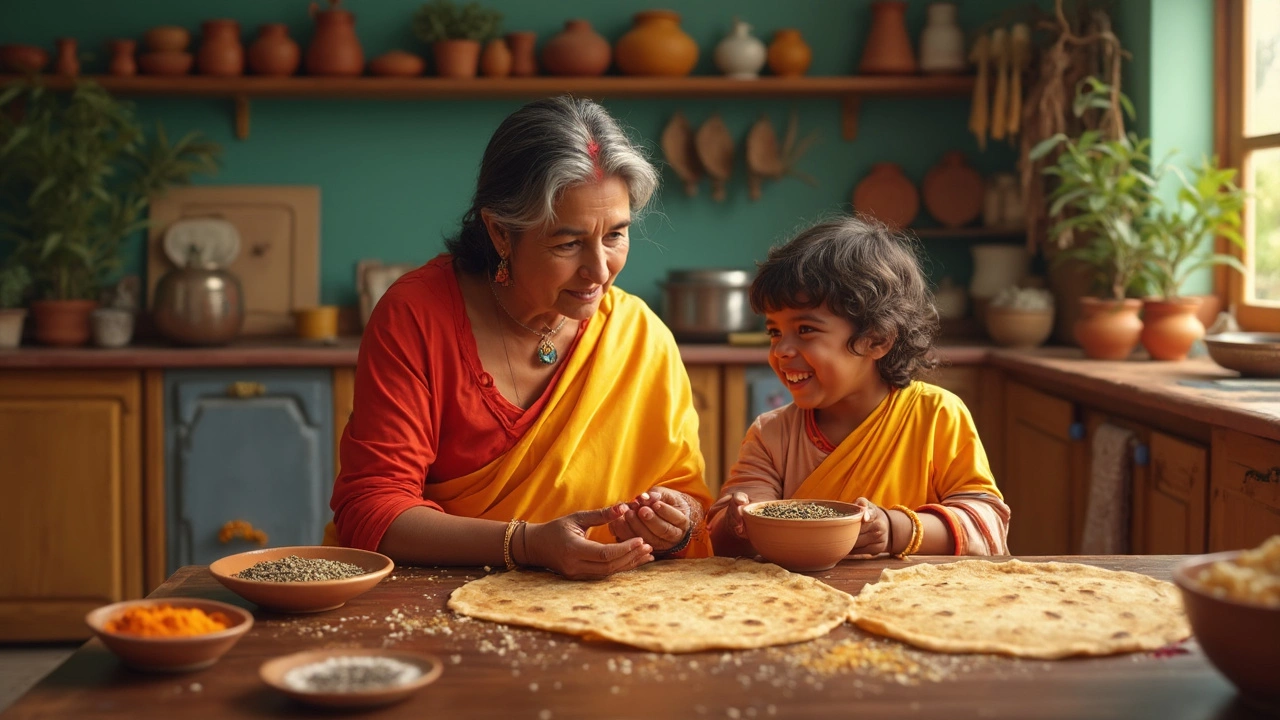Whole Wheat Roti vs. Multigrain Roti: Health Benefits Compared
 Feb, 18 2025
Feb, 18 2025
Alright, so you're standing in the kitchen, staring at a pack of whole wheat flour and a pack of multigrain flour. Which one should you grab for your next batch of rotis? Let's break it down so you can make the healthiest choice for your plate.
First off, if you're counting calories, you might wonder, 'How much calories in 1 roti?' A regular whole wheat roti weighs in at around 70-80 calories—nothing too crazy. On the other hand, add a dollop of ghee, and you're upping the game to about 100 calories per roti.
Now, compare this to multigrain roti, which might have similar calories in 1 roti, but packs in extra nutrients thanks to its mix of grains. The question is, are those extra nutrients making a difference to your health goals? Stick around to find out.
- Nutritional Breakdown
- Calorie Count: What’s in a Roti?
- Fiber and Nutrients: A Closer Look
- Health Benefits of Ingredients
- Choosing the Right Roti for You
Nutritional Breakdown
Understanding the nutritional makeup of your roti can be a game-changer in your quest for a healthy diet. Let's dig into what's really inside your whole wheat roti and multigrain roti.
Whole Wheat Roti
Whole wheat roti is pretty straightforward. Made from whole wheat flour, water, and a pinch of salt, it's a classic staple in Indian meals. Each roti usually contains about 70-80 calories primarily coming from carbs, with about 3 grams of protein and 0.5 grams of fat. It's got a nice dose of fiber too, thanks to the whole grains.
Multigrain Roti
Now, multigrain roti is where things get a bit more exciting. See, it isn't just wheat at play here. We're talking a mix of grains—often including millets, barley, soybean, oats, and more. So, what does this mean for you?
- Depending on the grain mix, each roti can contain around 80-100 calories.
- Higher protein content – expect up to 4 grams per roti.
- Richer in fiber and essential nutrients like B vitamins and minerals.
Here's a quick comparison table to give you a visual:
| Type | Calories | Protein (g) | Fiber (g) |
|---|---|---|---|
| Whole Wheat Roti | 70-80 | 3 | 2.5 |
| Multigrain Roti | 80-100 | 4 | 3.5 |
Choosing Based on Nutritional Needs
If you're after more fiber and a variety of nutrients, then multigrain might be your pick. However, if keeping things simple is key, whole wheat does just fine. Remember, it depends on what you're pairing it with too! For instance, if you're thinking about calories in 1 roti and sabzi, consider what goes best with your meal plan.
So, there you have it. Next time you’re deciding which flour to dust off, think about what kind of nutrition boost you’re looking for. Whether it’s the simplicity of whole wheat or the nutritional powerhouse of multigrain, both have their perks!
Calorie Count: What’s in a Roti?
Okay, let's talk about calories in 1 roti. Whether you're throwing on your chef hat or simply curious about that warm, fluffy flatbread you're about to munch on, getting to know its calorie content can be pretty enlightening.
Basic Breakdown
When you make a basic whole wheat roti, you're looking at about 70-80 calories in 1 roti. If you're teaming it up with sabzi, the calorie count will change depending on what veggies and how much oil you use, but it's roughly around 200-300 calories per meal.
Spicing it Up with Ghee
If you love the taste of ghee (who doesn't?), note that a single roti with ghee might jump up to around 100 calories in 1 roti with ghee. It’s a tiny indulgence, but also a calorie booster.
Multigrain Magic
The interesting part? Multigrain roti might have a similar calorie range, but you're getting a better deal on fiber and nutrients thanks to the various grains mixed in. Imagine stuffing yourself with a blend of fiber-rich goodness!
- Step 1: Go whole grain if you’re keeping it simple and sticking to tradition.
- Step 2: Add ghee if you’re after that richness—know it comes with a calorie bump.
- Step 3: Pick multigrain for added nutrients, especially if you're looking to boost your fiber intake.
Ultimately, the right roti depends on your dietary goals, but knowing the how many calories in 1 roti helps in balancing those choices. Keep these ideas close next time you’re making or ordering a roti. It’s all about making informed and delightful decisions for your health!

Fiber and Nutrients: A Closer Look
Now, let's dive into something essential—fiber and nutrients. Whether you're munching on a whole wheat roti or a multigrain roti, you're getting some fantastic stuff for your body. But which one gives you more bang for your buck? Let's find out.
Whole Wheat Roti: Steady and Reliable
A whole wheat roti is well-known for its decent fiber content, thanks to the unrefined flour used. One regular roti gives you about 2 grams of fiber. This might not seem like much, but each bit helps keep things moving in your digestive tract.
Whole wheat is also packed with essential nutrients like iron, magnesium, and B vitamins. These nutrients are critical—they help in everything from keeping your energy levels up to making sure your muscles and nerves are working properly. Not too shabby for a staple meal item!
Multigrain Roti: Nutrient Powerhouse
Now, over to the multigrain roti. As the name suggests, it's a mix—typically combining grains like barley, oats, and millet. This mix results in a nutritional powerhouse. You can expect higher fiber content, often around 3-4 grams per roti depending on the specific grains used.
Besides, the variety of grains means you're getting a diverse range of nutrients. Think about zinc, selenium, and antioxidants all wrapped up in one. Those nutrients can play a huge role in boosting your immune system and keeping your skin looking great.
The Bigger Picture
When it comes to choosing between the two, it really depends on what you're after. If you're looking for a wide range of nutrients, perhaps you're leaning towards multigrain. But maybe you're someone who just loves the classic comfort a whole wheat roti brings.
The good news? You can't go wrong with either choice when aiming for healthy fiber and nutrients. Just remember to enjoy it alongside a balanced diet. And hey, if you're feeling creative in the kitchen, try making both types of roti and see which suits your taste buds or dietary goals best. Mixing things up can be both fun and beneficial for your health!
Health Benefits of Ingredients
You might be wondering what makes whole wheat or multigrain roti the better choice. It all boils down to the ingredients. Let's talk about how each ingredient can kick your health up a notch.
Whole Wheat Roti: The Fiber Boost
Whole wheat roti is a classic for a reason. Its main claim to fame is the high fiber content that aids digestion and keeps you full. If you're watching your weight, this is a big bonus. According to nutritionist Rachael Adams:
"Whole grains are packed with nutrients including protein, fiber, B vitamins, and antioxidants. They're known for reducing the risk of heart disease and improving overall digestive health."
Multigrain Roti: A Nutritional Powerhouse
Now, let's look at the superhero squad in multigrain roti. It usually includes grains like barley, millet, oats, and even quinoa. Each of these grains brings something unique to the table.
- Barley: Great for reducing blood sugar spikes and keeping your heart healthy.
- Millet: Packed with magnesium, it's fantastic for bone health.
- Oats: High in beta-glucans, helping in cholesterol control.
- Quinoa: A complete protein source with essential amino acids.
With this lineup, multigrain roti can give you a well-rounded nutritional profile.
| Grain | Health Benefit |
|---|---|
| Barley | Lowers cholesterol levels |
| Millet | Supports bone health |
| Oats | Improves heart health |
| Quinoa | Complete protein source |
Solving the Dilemma
Having trouble choosing? Here's a practical approach: if you need more dietary fiber and prefer a simpler ingredient list, go for whole wheat roti. But if you're in the game for diverse nutrients and extra energy, multigrain roti is your go-to.
Ultimately, the choice between these rotis depends on your personal health goals. Trying both might even give you the best of both worlds!

Choosing the Right Roti for You
Picking the right roti to grace your meal isn't just about flavor—it's about fitting your lifestyle and health goals. So, how do you decide whether to go for a whole wheat roti or a multigrain roti?
Consider Your Nutritional Needs
If you're looking for simplicity and a well-known nutritional profile, whole wheat roti might be your top pick. It offers a reliable source of fiber and essential nutrients. But if you're seeking a broader range of grains and potentially more diverse nutrients, multigrain rotis are worth exploring. They often include grains like barley, oats, and millet, which bring their own set of benefits.
Check Your Dietary Goals
- Weight Management: Sticking to your calorie goals? Remember, how much calories in 1 roti can vary slightly, but both options are roughly similar if you control portion sizes.
- Boosting Fiber: Multigrain options might give you a bit more fiber, lending a helping hand to your digestion.
- Allergen Awareness: If you have specific grain allergies, read the labels carefully on multigrain mixes to avoid any surprises.
Experiment for Taste
Let's face it, at the end of the day, taste matters. If you're all about experimenting with flavors, go ahead and try both. You might surprise yourself with how much you enjoy the variety that multigrain roti adds to your meal. Experimenting is key to finding out what suits your taste buds the best while aligning with your health goals.
Remember, the best choice is one that fits your nutritional needs, boosts your wellness goals, and keeps you enjoying every bite. So roll up your sleeves, grab some flour, and start your delicious journey!